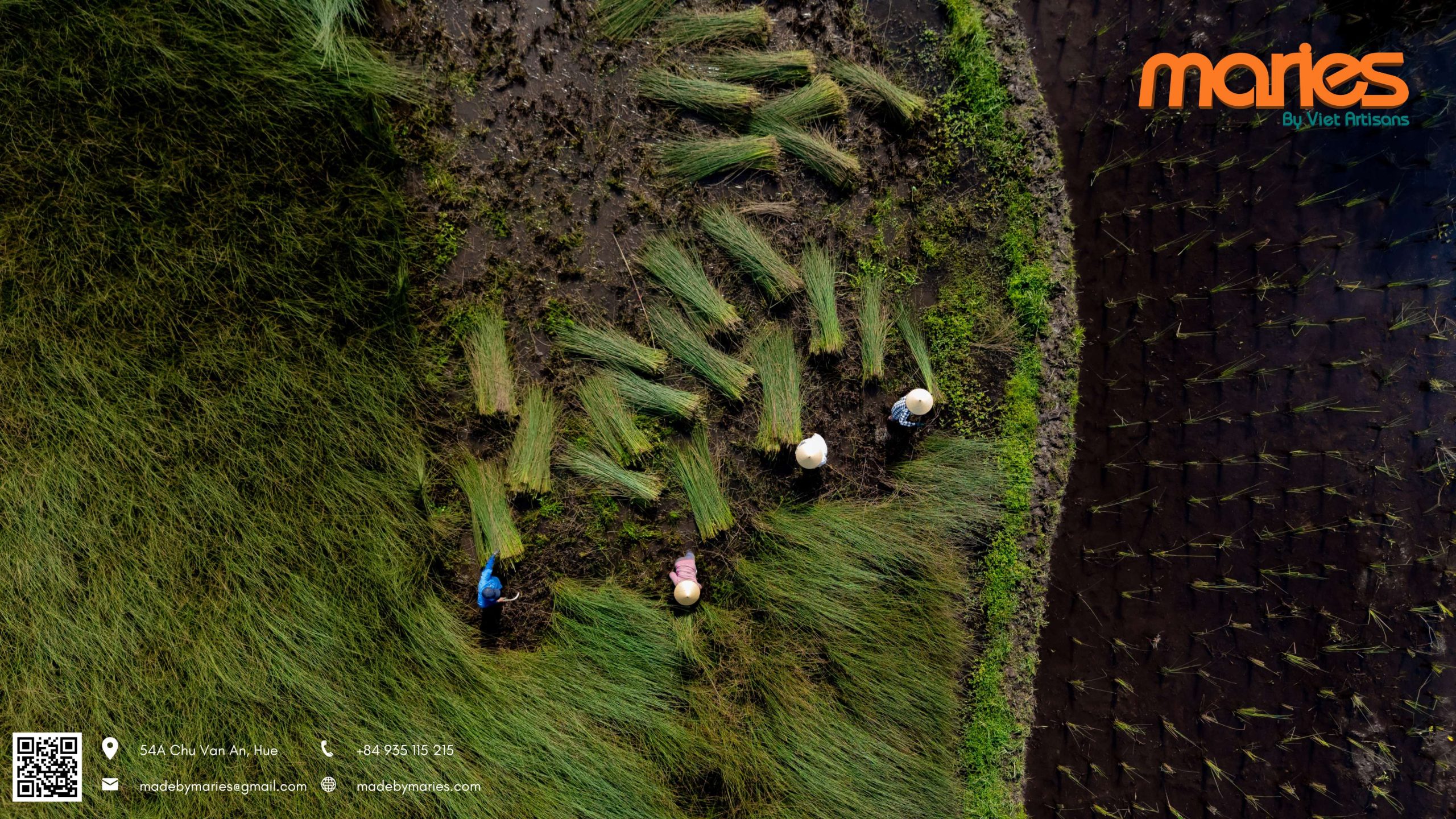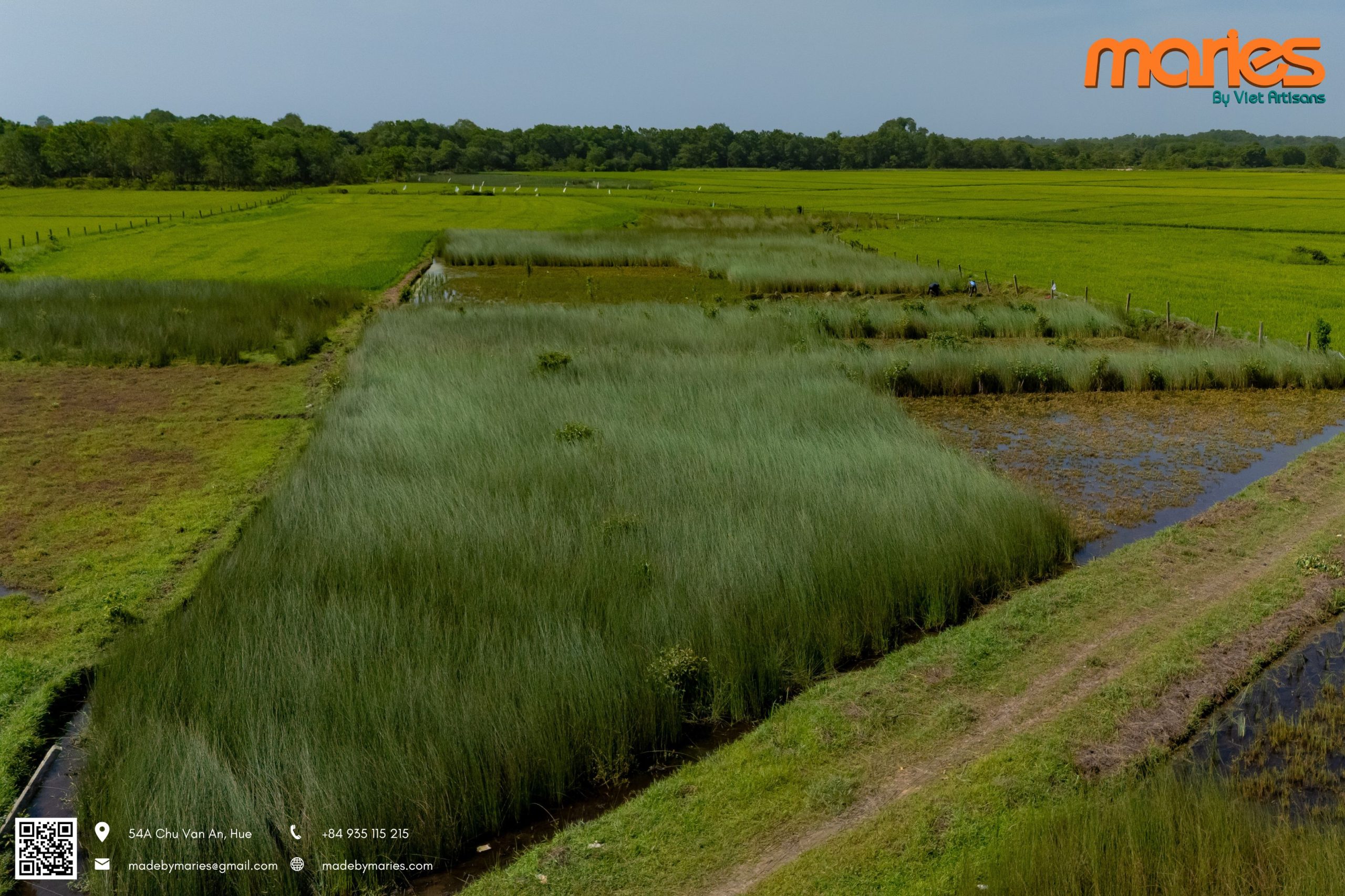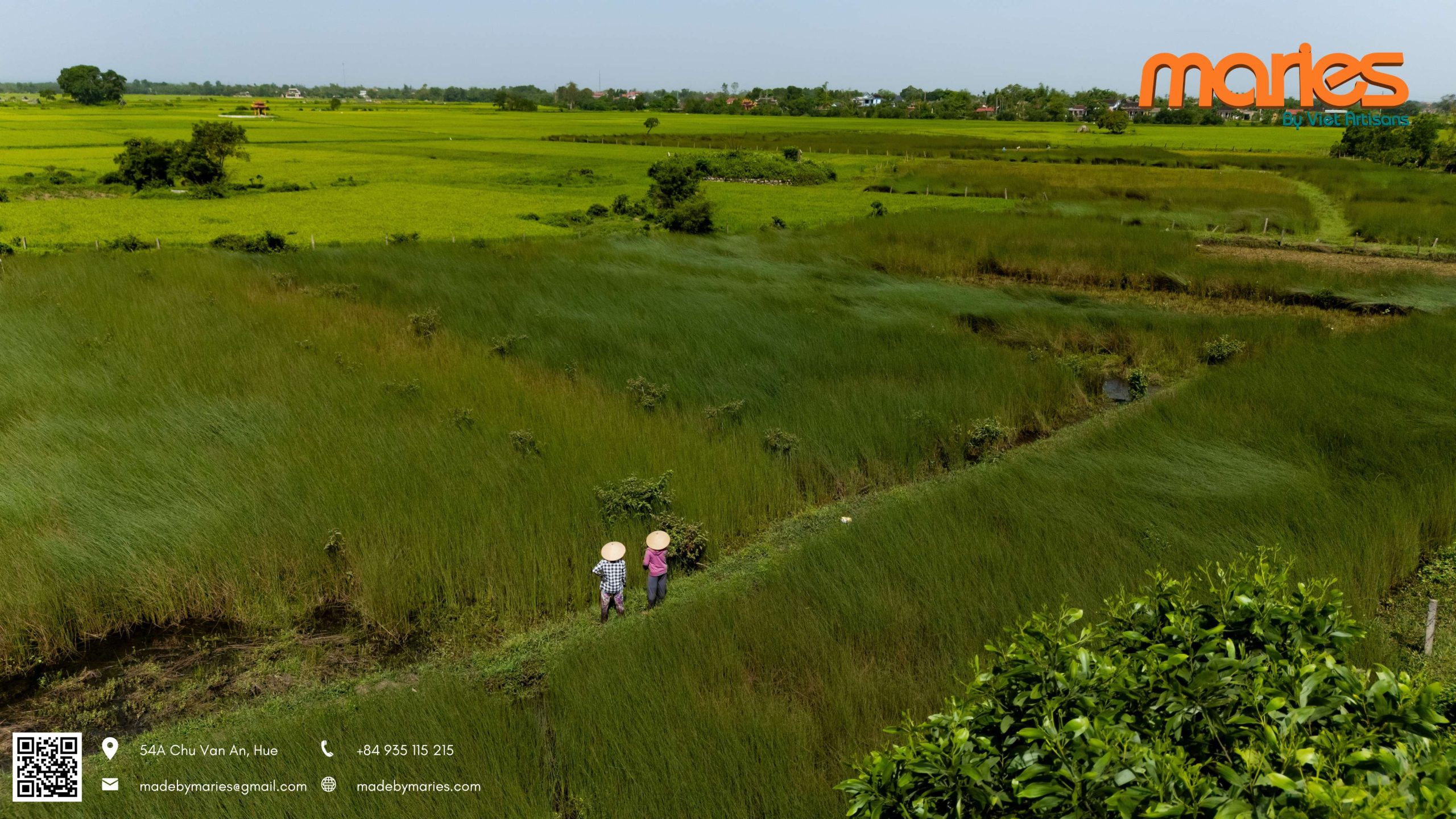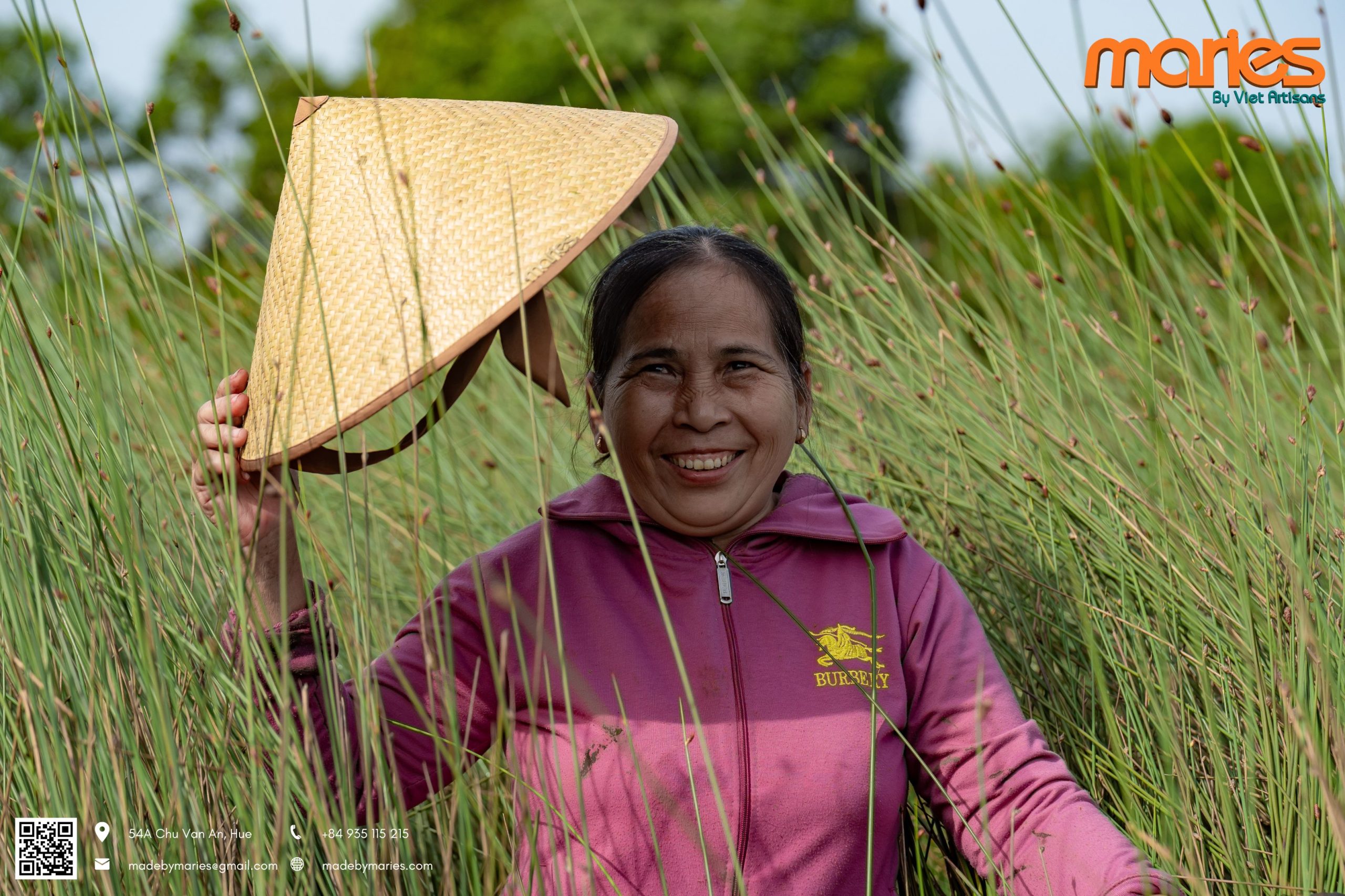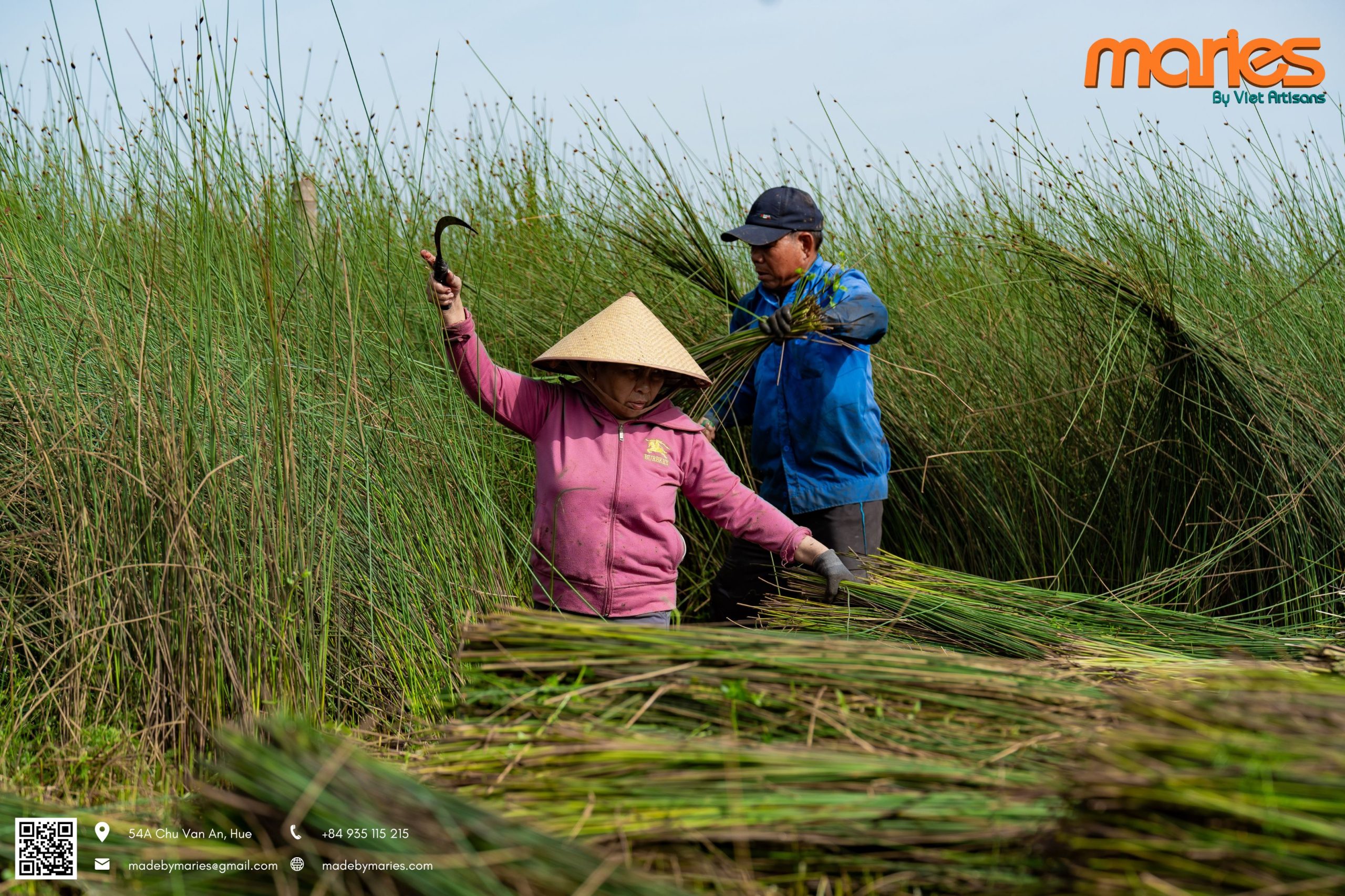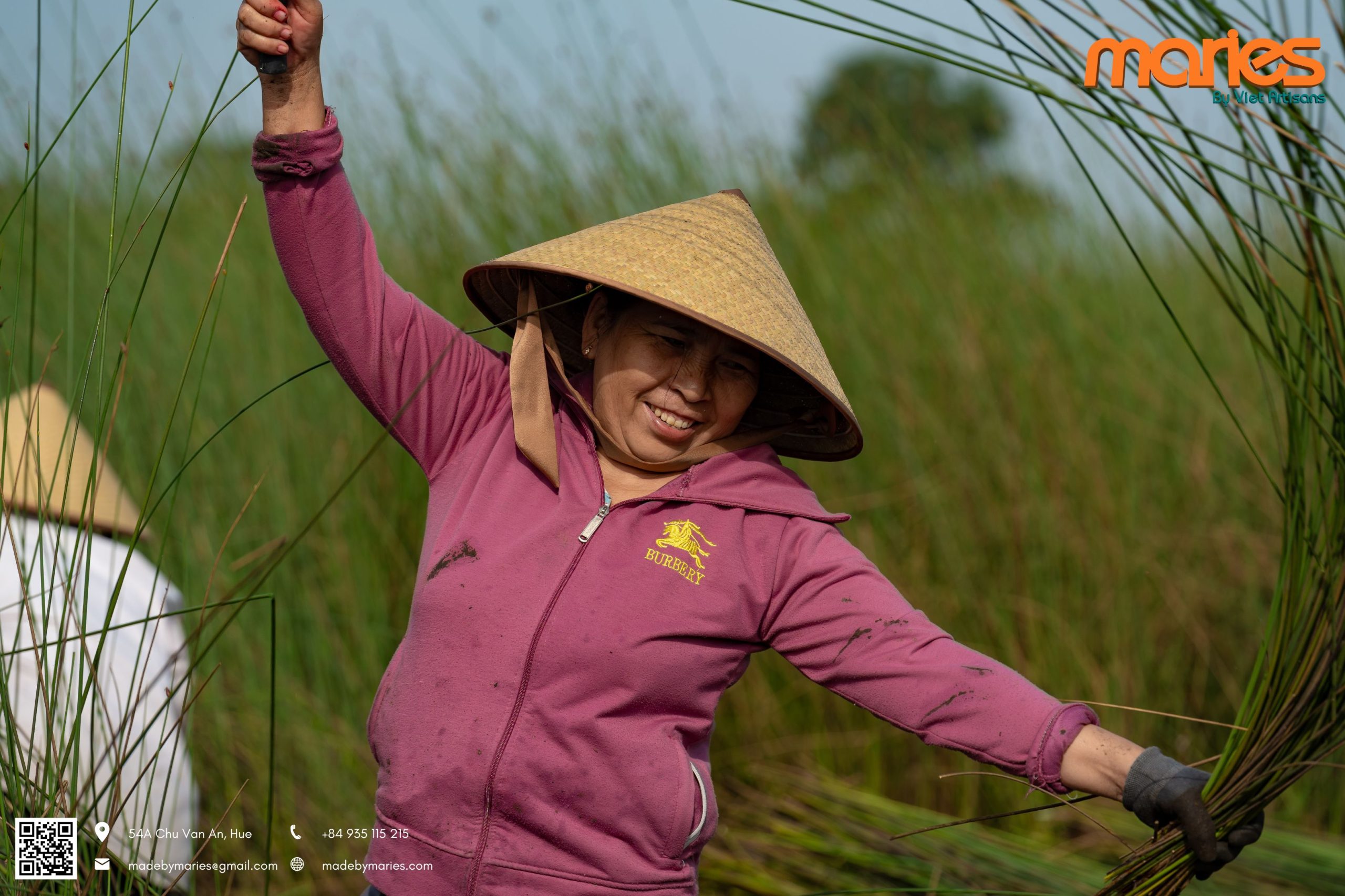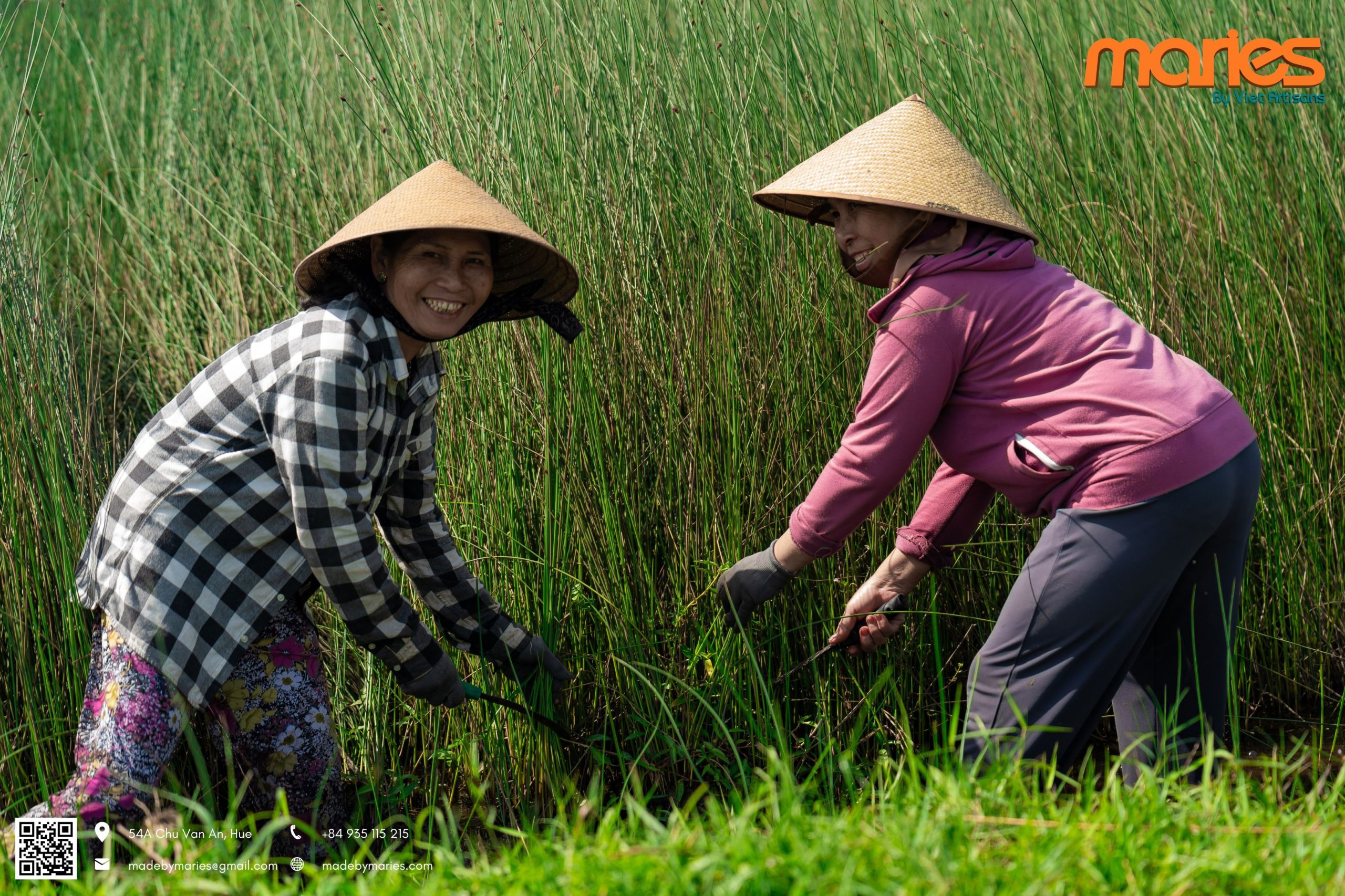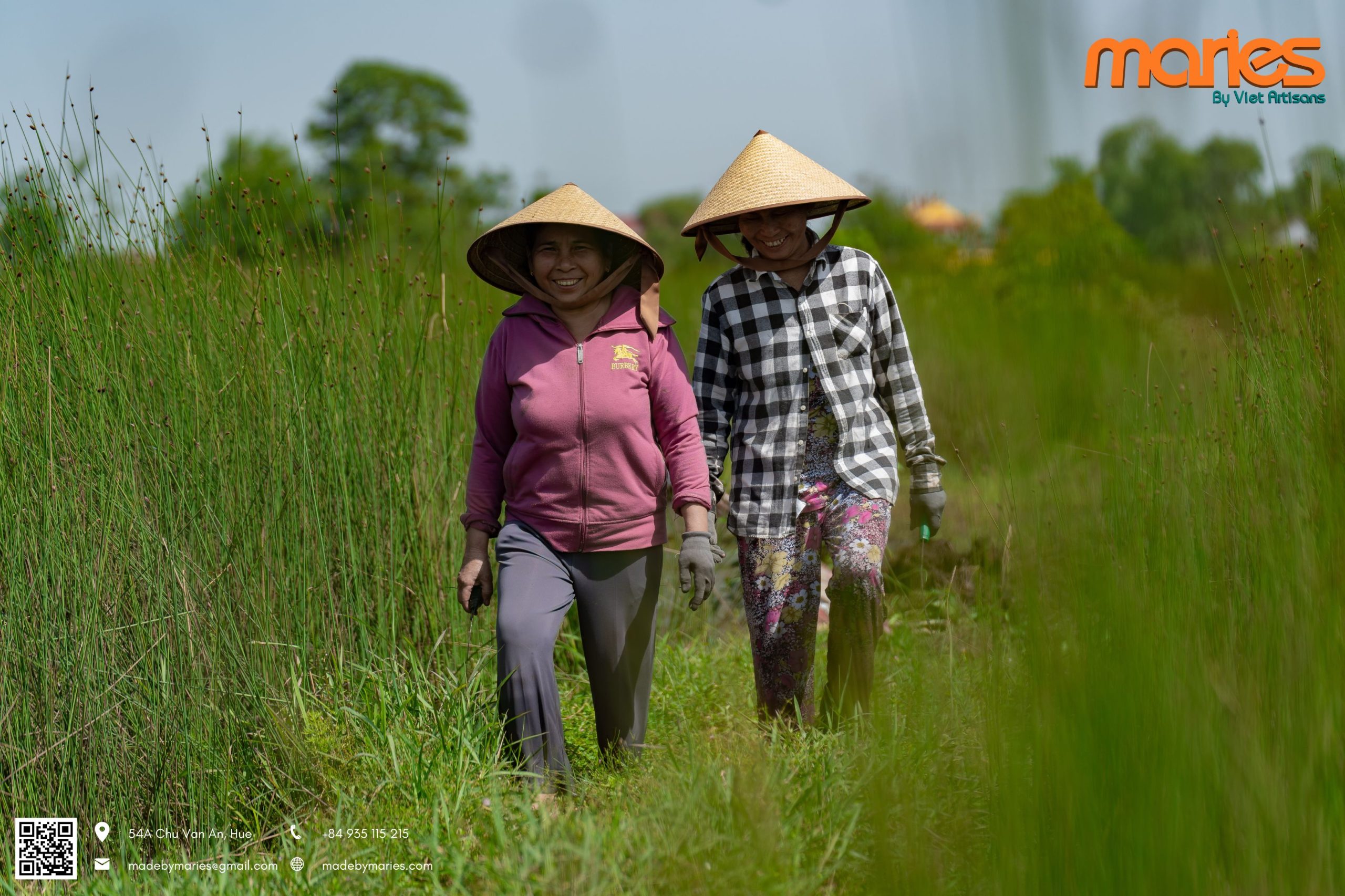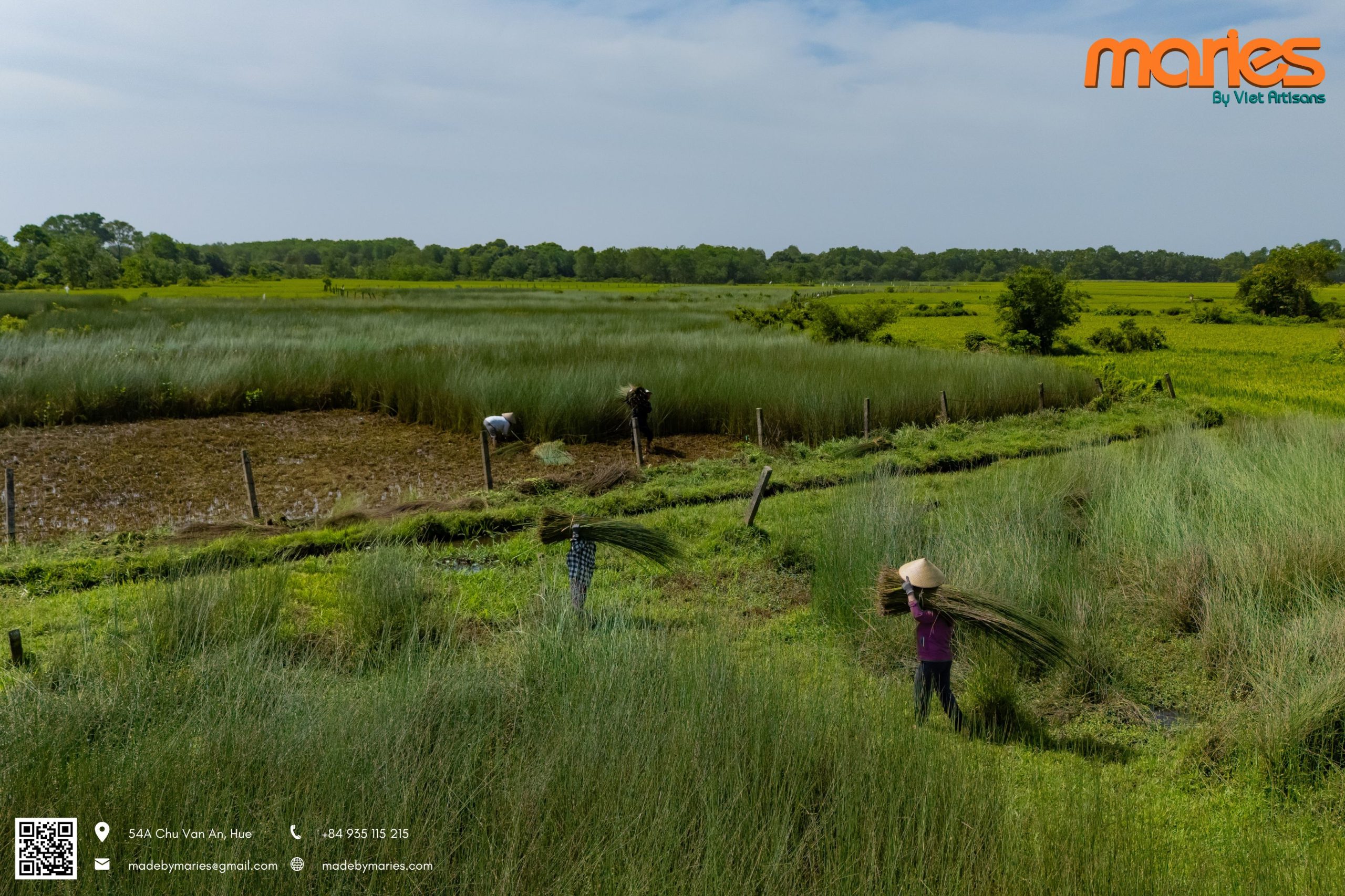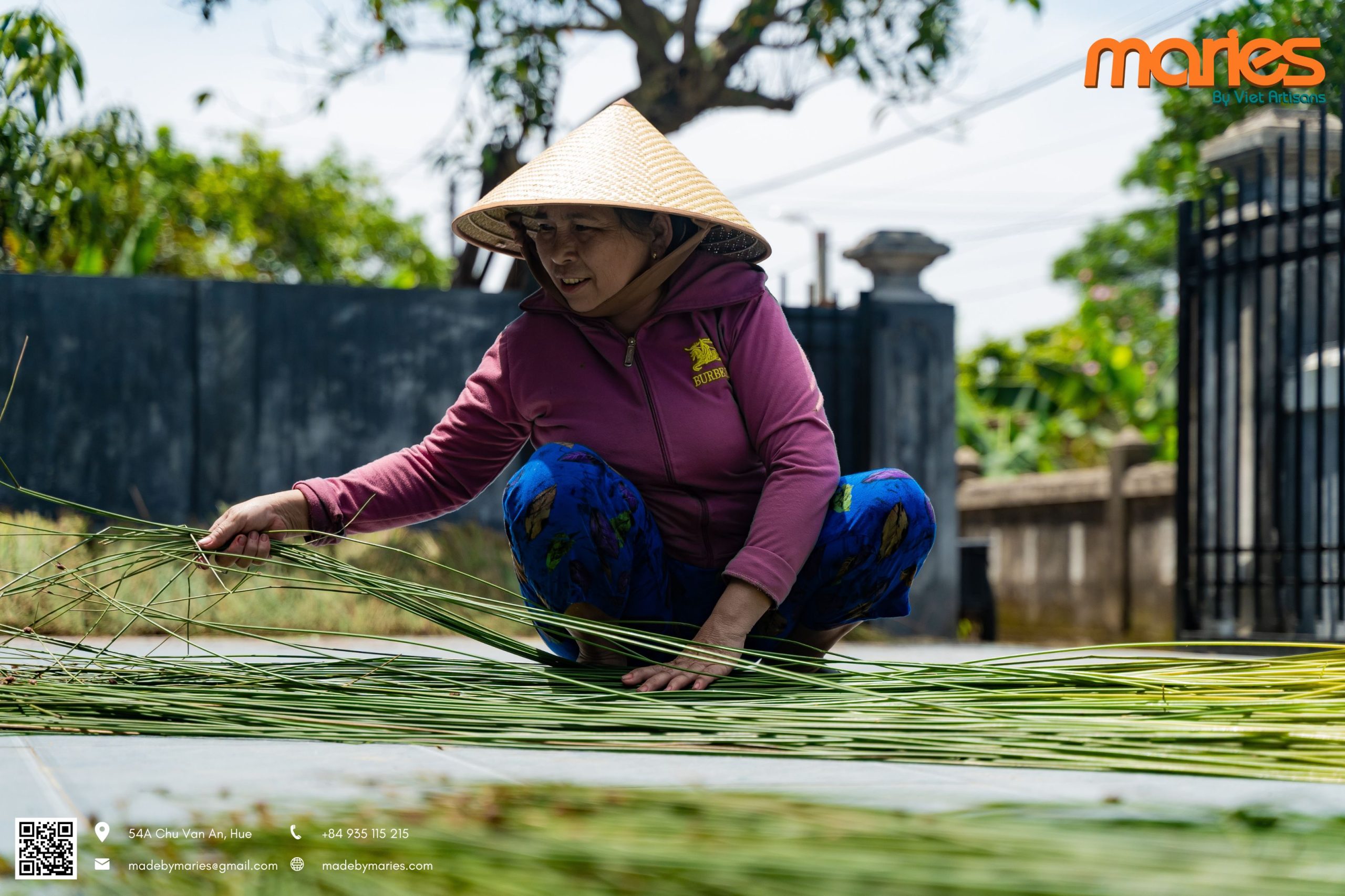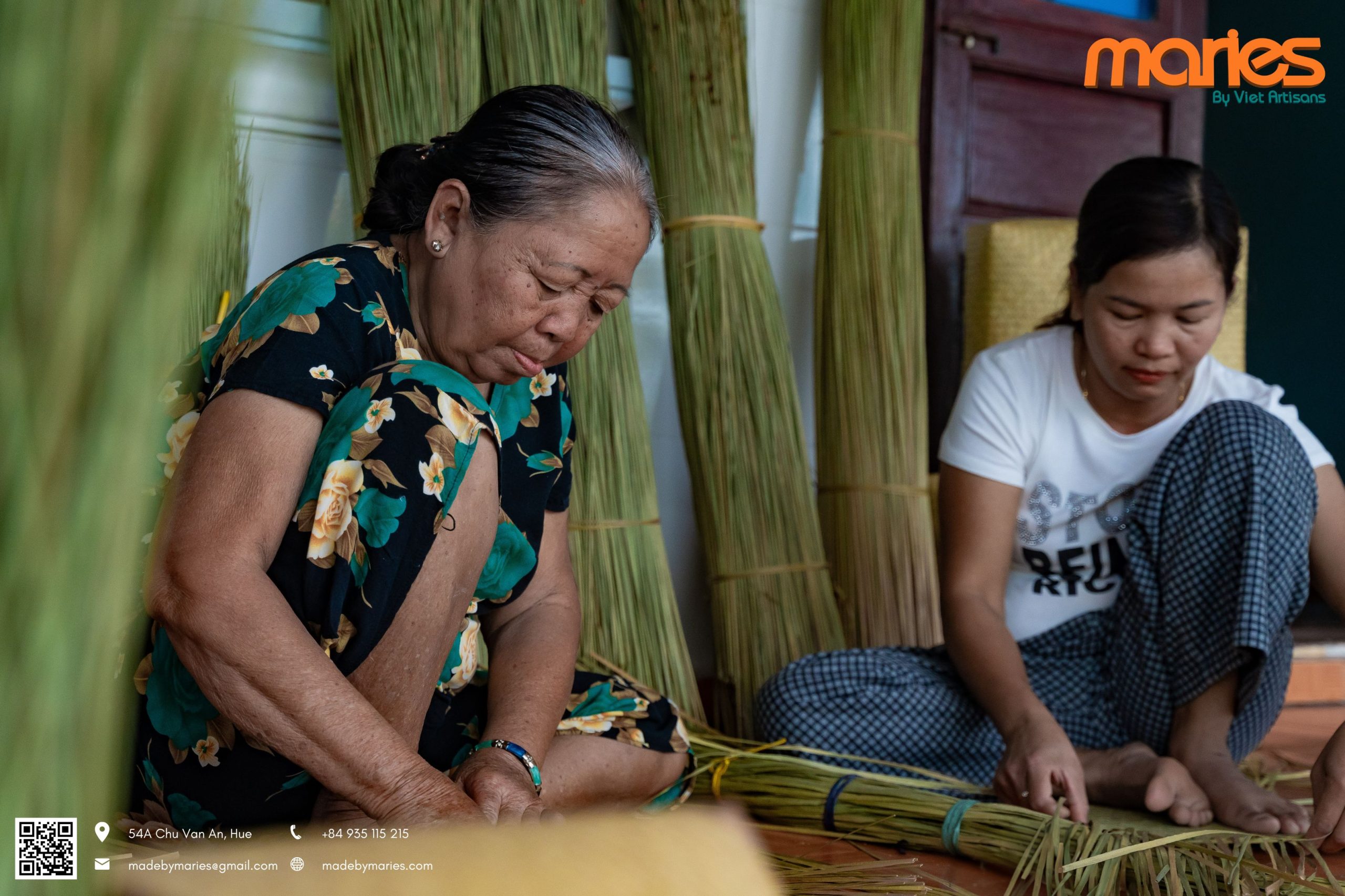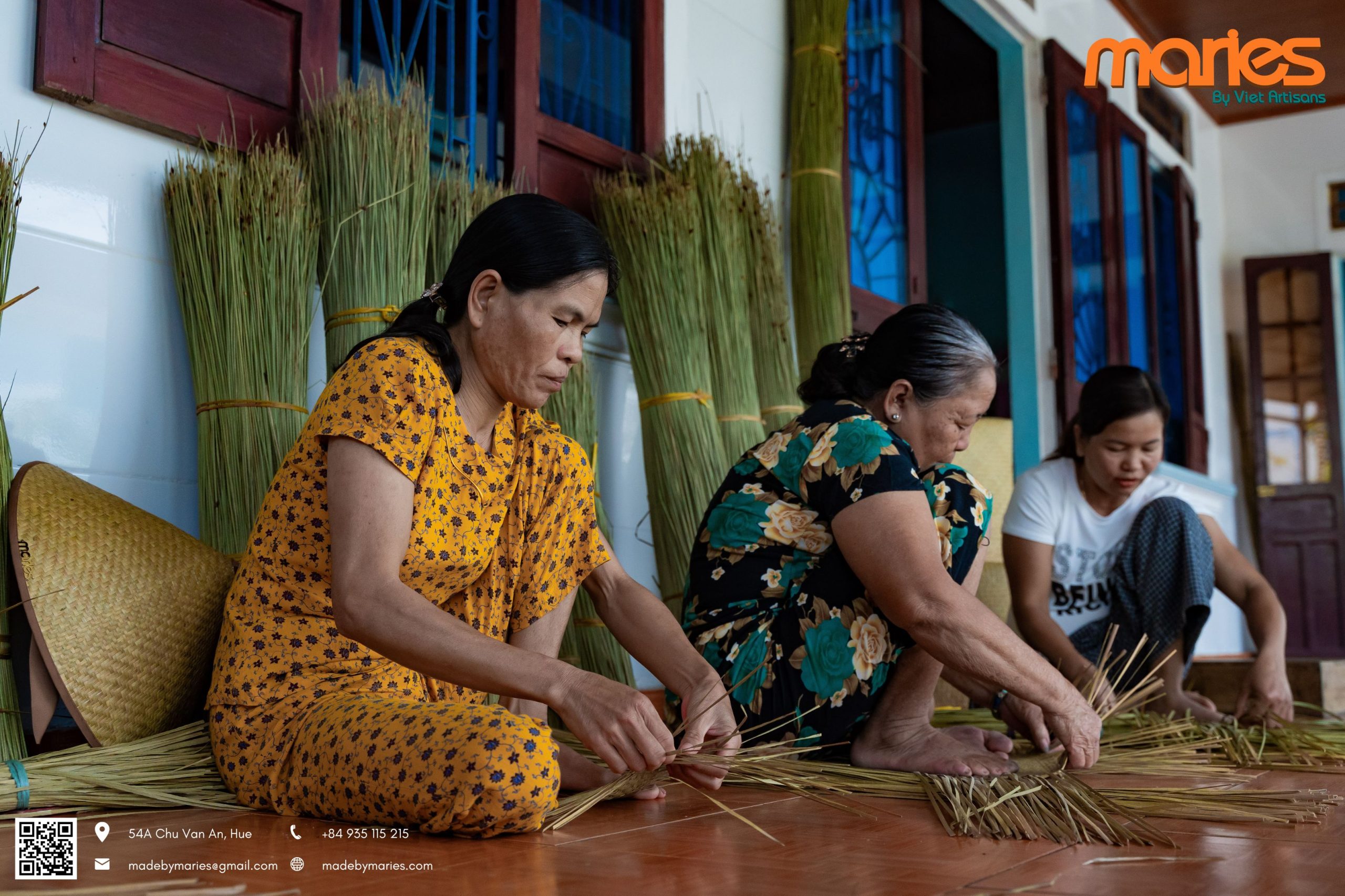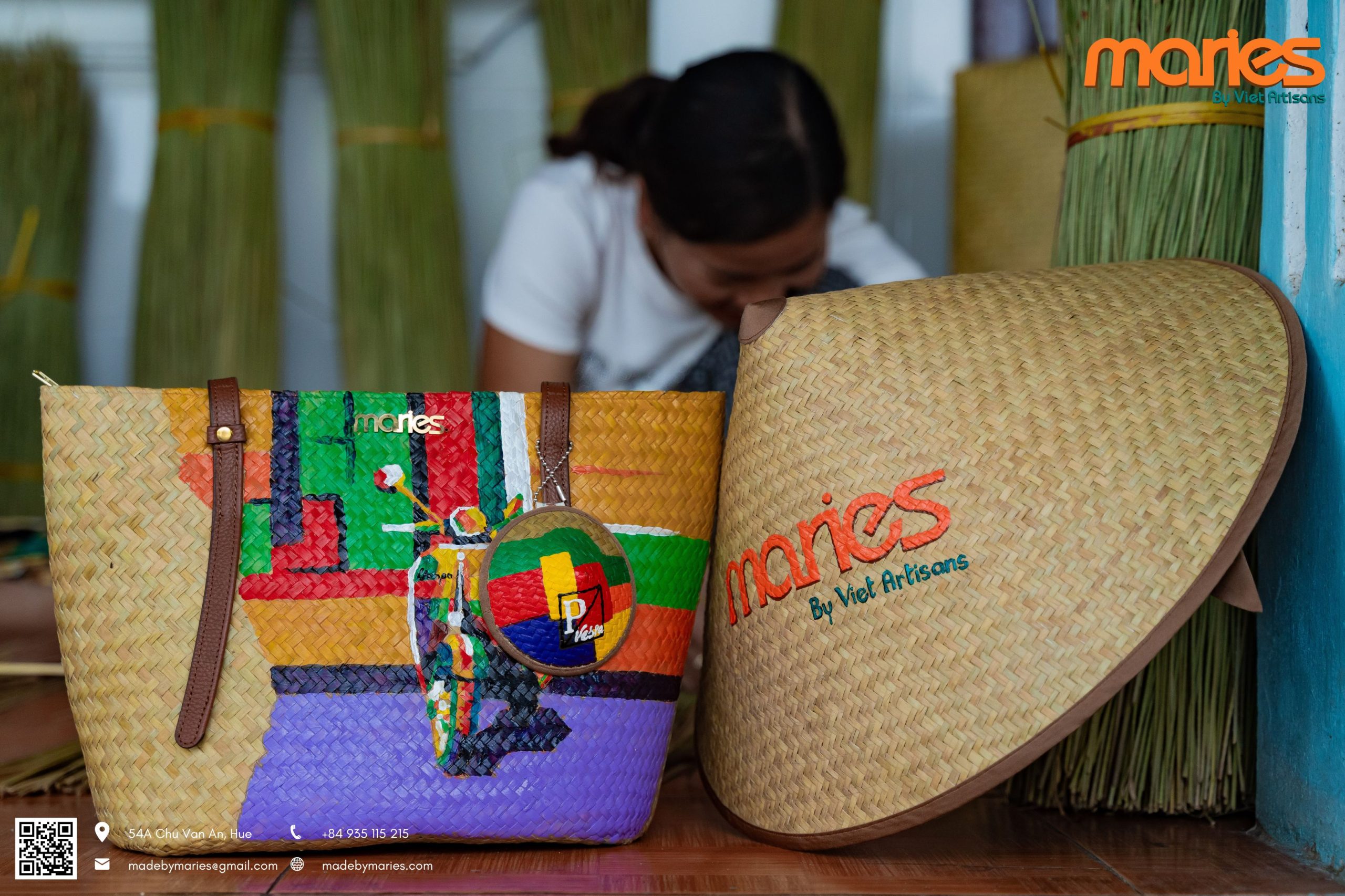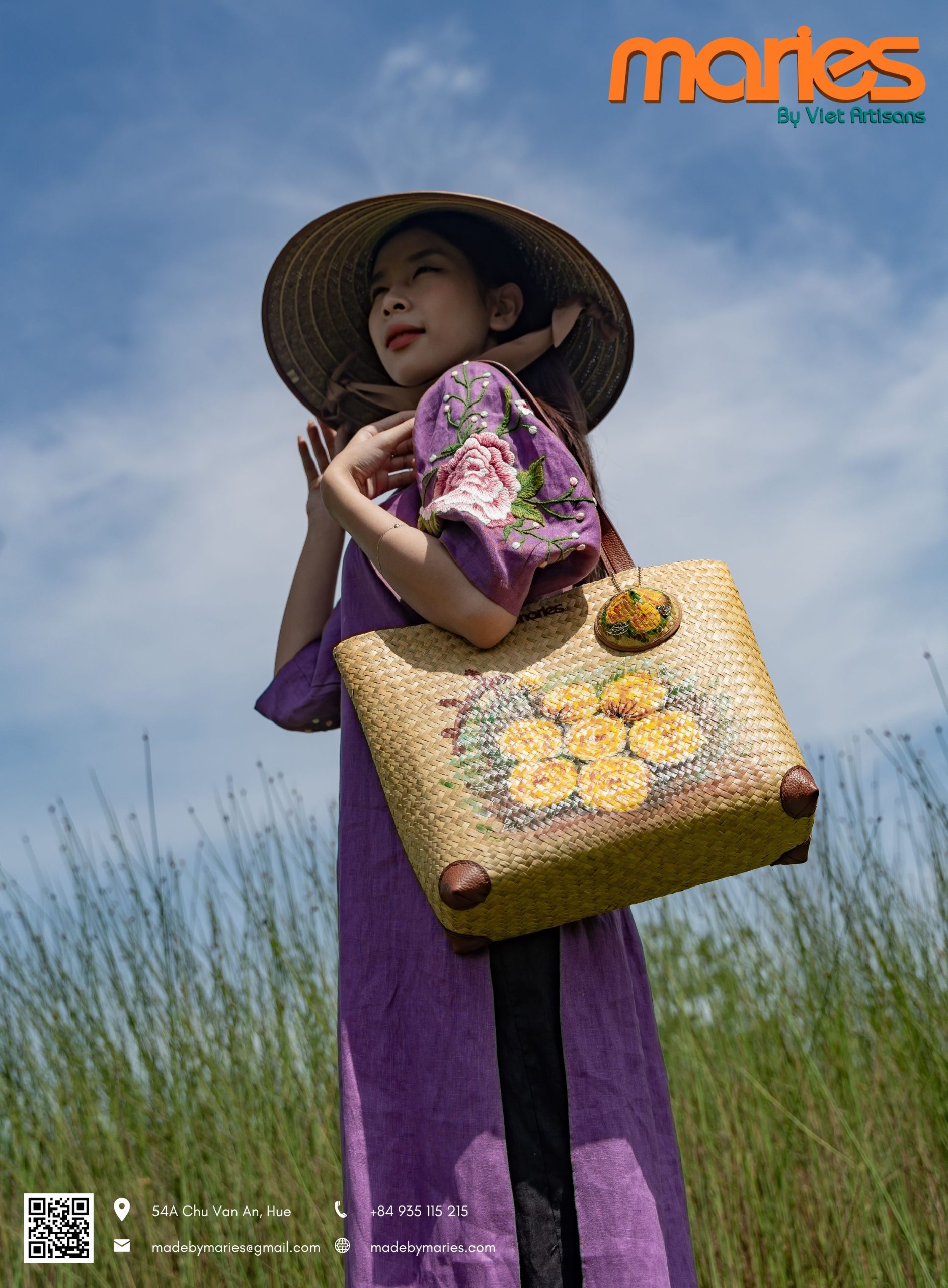Lepironia Grass Harvest Season 2025 – When Each Lepironia Grass Strand Becomes a Bridge Reviving a Village Craft
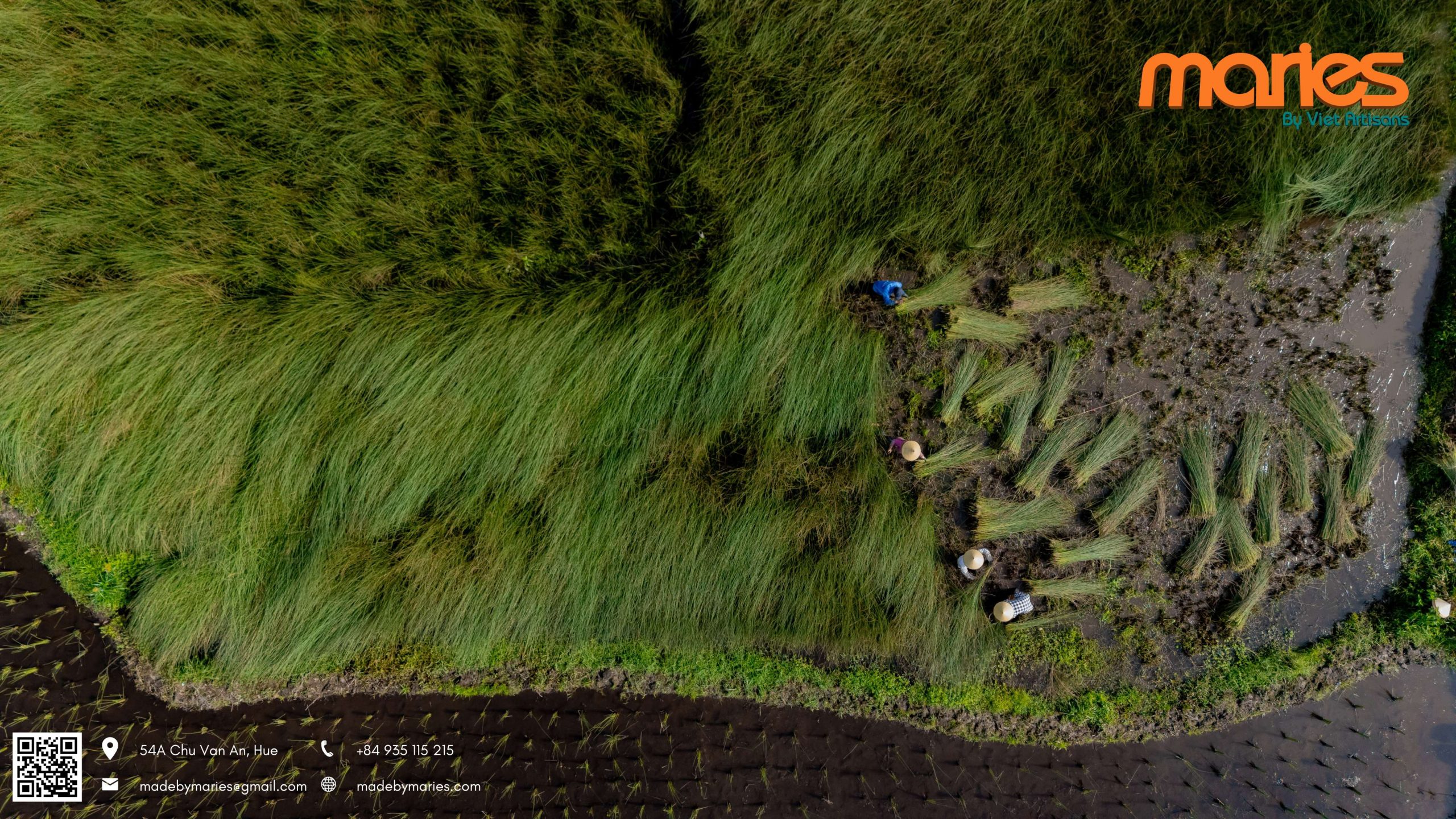
“Harvesting isn’t just cutting – it’s preserving.
Preserving the grass – preserving the craft – preserving the village!
So that each strand of Lepironia grass becomes more than just a wild plant,
but a bridge between past – present – and future.
A living tradition passed on. A legacy carried forward.”
These days, whenever the 7 PM national news airs, Aunt Liên’s whole family huddles around the TV, eyes glued to the weather forecast. The moment they hear “tomorrow will be sunny,” they exchange bright smiles. Alright then—up early tomorrow to harvest the Lepironia grass!
Before 5 AM, even before the sun peeks over the horizon, groups of villagers are already heading out, sickles in hand, shoulder poles across their backs, conical hats on their heads—ready for a long day in the fields.
Lepironia Grass Harvest – Preserving a Craft, Preserving a Village
In Phò Trạch, a small village north of Huế, Lepironia grass isn’t just a wild plant—it’s a gift from nature, deeply woven into the daily life of the people. It grows in low-lying, waterlogged lands all year round. Beneath your feet is soft, squishy mud, sometimes knee-deep. Overhead is the blazing sun, while around you, the whispering rustle of grass sings a lullaby.
When April arrives with its distinct sunlight, Phò Trạch awakens. This is not just any sunlight—it’s dry, searing, the kind the villagers trust as the signal to head into the fields. For these craft artisans, Lepironia season is a time of busyness, hope—and suspense. A good harvest depends on watching the weather day by day. The sun must stay out, steady and hot. No sudden showers, no thunderstorms. Only then do they dare harvest. After cutting comes drying. Then comes guarding against wind, or an unseasonal rain that could ruin all the half-dried grass strands in a single afternoon.

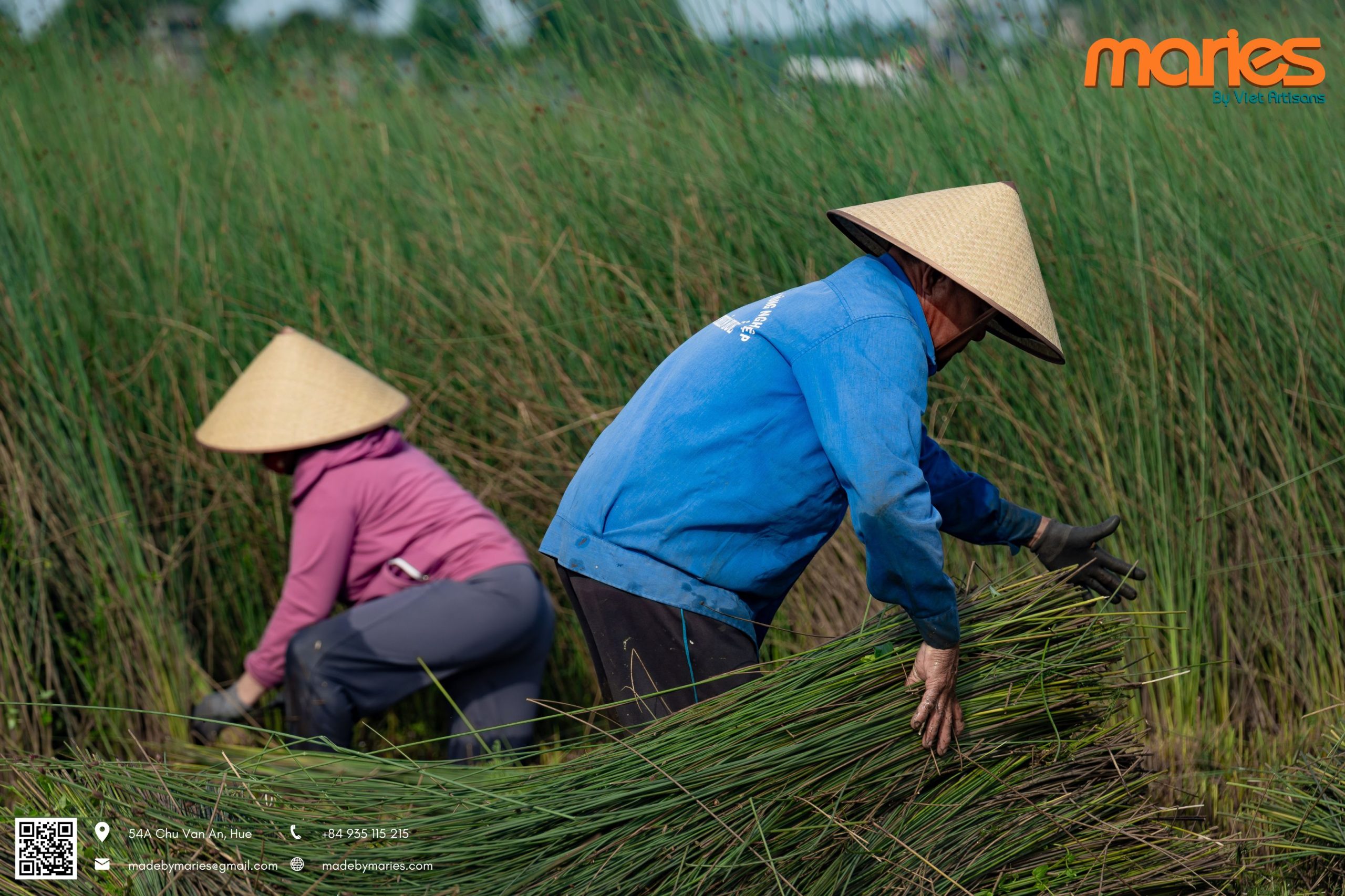
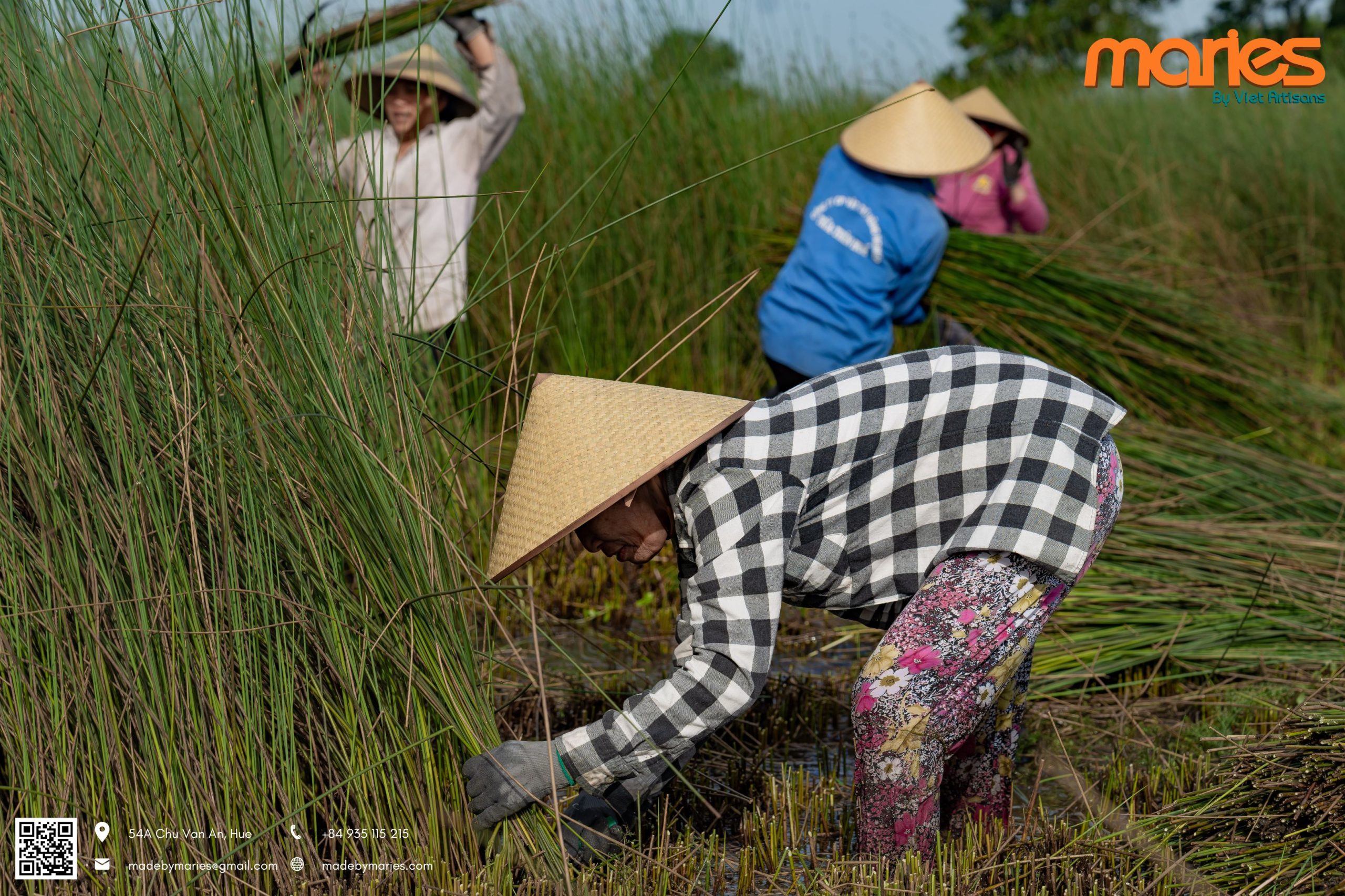
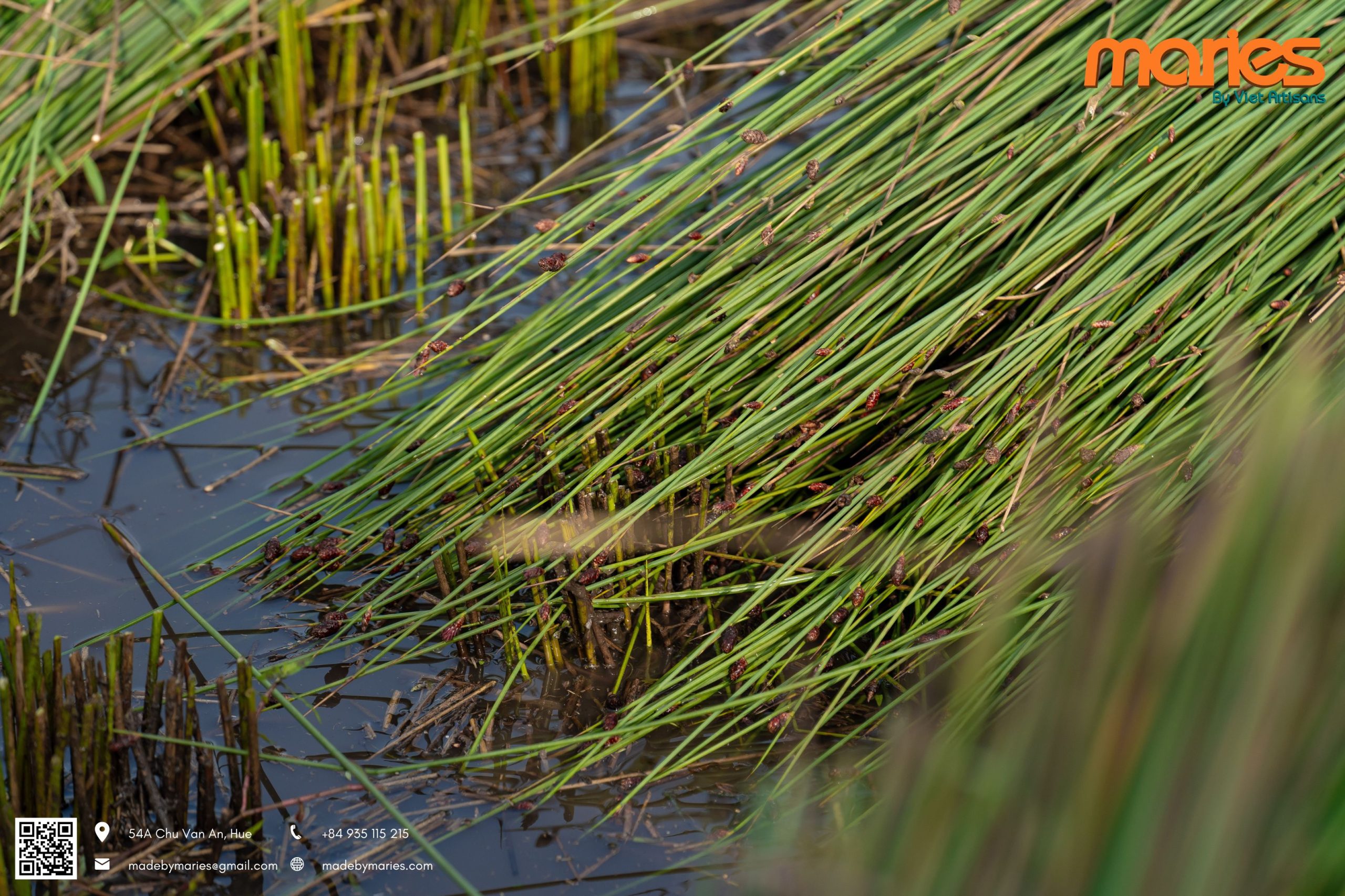
The Lepironia fields may look like a tranquil painting, but harvesting is no gentle task. The grass grows tall and dense—taller than a person—with sharp stalks reaching toward the sun. Walking through them is like parting your way through a green forest. Just a moment of distraction, and your face might be scratched by a sharp edge, stinging like bamboo thorns.
With sharp sickles, each clump is cut near the base and bundled into thick sheaves. One bundle weighs about 10 kilograms—but under the blazing 36–37°C sun, wading through waterlogged soil, it feels like carrying the sun itself on your back.
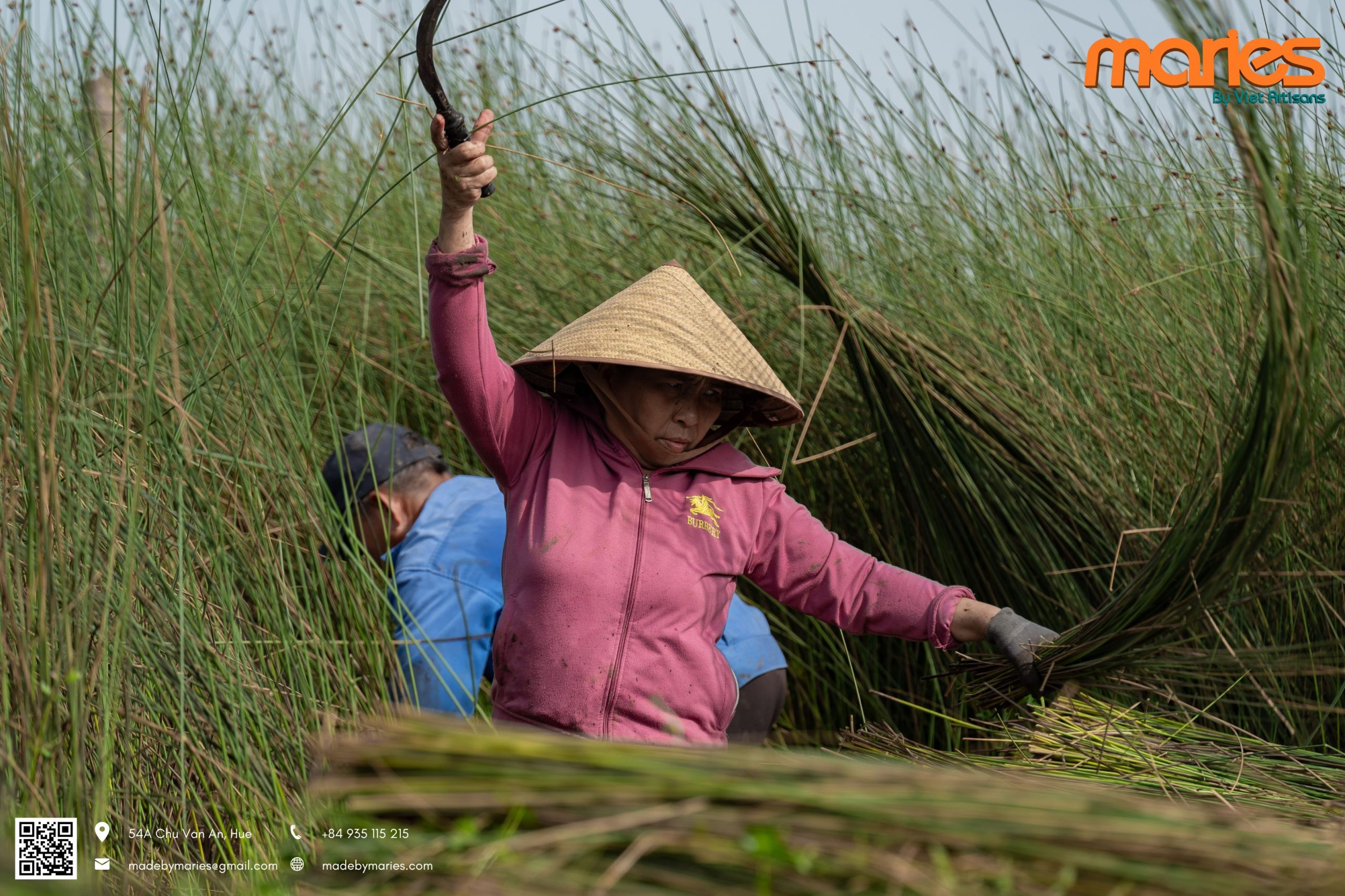

“You’ve got to start early,” Aunt Quý says, laughing as she re-ties her hair beneath her hat. “Later in the day, the heat turns the water under your feet scalding. Some days, the sweat dries right on your skin.”
Their hands are sun-darkened, their fingertips cracked, yet incredibly gentle as they stroke each grass strand.
Even when Uncle Thành’s foot is bitten by a leech, bleeding red through the sole, he smiles and says, “It’s alright—this blood will raise a few beautiful bundles of grass.” That’s how villagers speak of their craft—with humility, quiet resilience, and a deep, wordless affection.
Each day starts before 5 AM. Before the sky fully brightens, they’re already on their way, bringing along some rice cakes, a thermos of tea, and a few damp towels.
“Morning cuts save your skin from burning,” Uncle says, though by noon everyone is soaked with sweat. Their shirts cling wetly, hats drenched, feet caked in mud—but hands still work the sickles with steady rhythm.

And yet, everyone smiles. There’s joy—joy because the grass this year is thriving, because orders came in early, because the young ones in Huế texted home, “This design’s a bestseller!”, because now they know their work has a future.
No more making products and piling them up, hoping someone would come, like waiting for rain in a dry season.
“Back then, we made things not knowing if anyone would buy. Now, orders come in advance. We know these products are headed abroad. Of course we’re happy!”
And so, under the scorching sun, across the rustling grass fields, laughter echoes.
Not carefree laughter—but laughter rooted in faith: that somewhere, young people are waiting for these strands of grass to be reborn as beautiful, meaningful products.
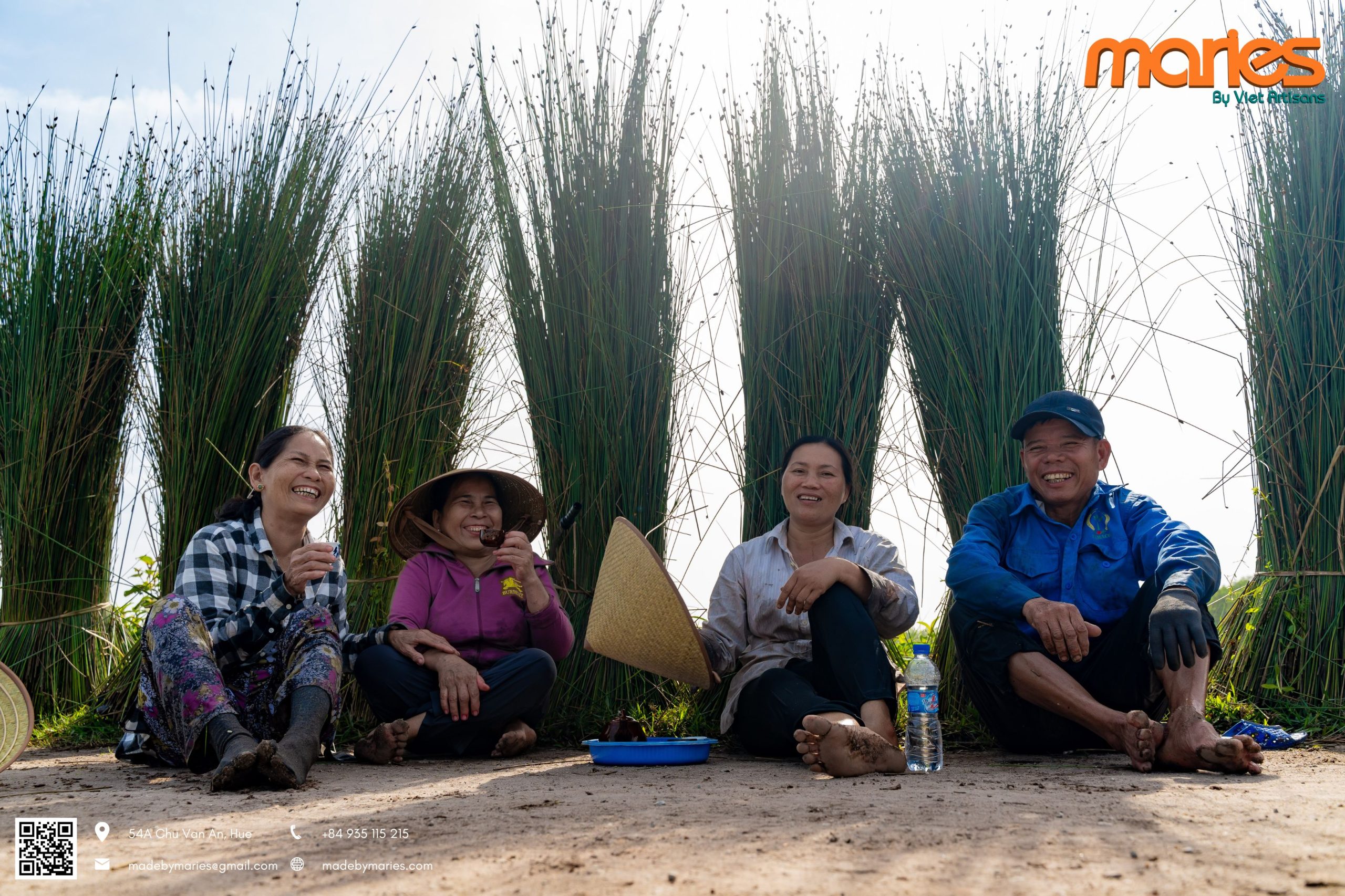

An Ancient Craft – A New Spirit
The harvest doesn’t end in the fields. Once home, the bundles of Lepironia grass are spread out carefully in the yard—layer by layer, aligned with the sun, matched with the wind.
Each strand is fanned out like a pinwheel across the courtyard.
Children run barefoot around their grandmothers, laughing as they dart between the warm, fragrant rows. They run out, run back inside for cartoons, then run out again—like the drying yard is part of their sunlit childhood.
Every step is shaped by human hands: smoothing, sorting, flattening. Each bundle is separated by age, color, and length, destined for different creations. From humble grass to handbags, hats, charms—still bearing the soul of the land.
Right here, products infused with Vietnamese identity begin to take form.
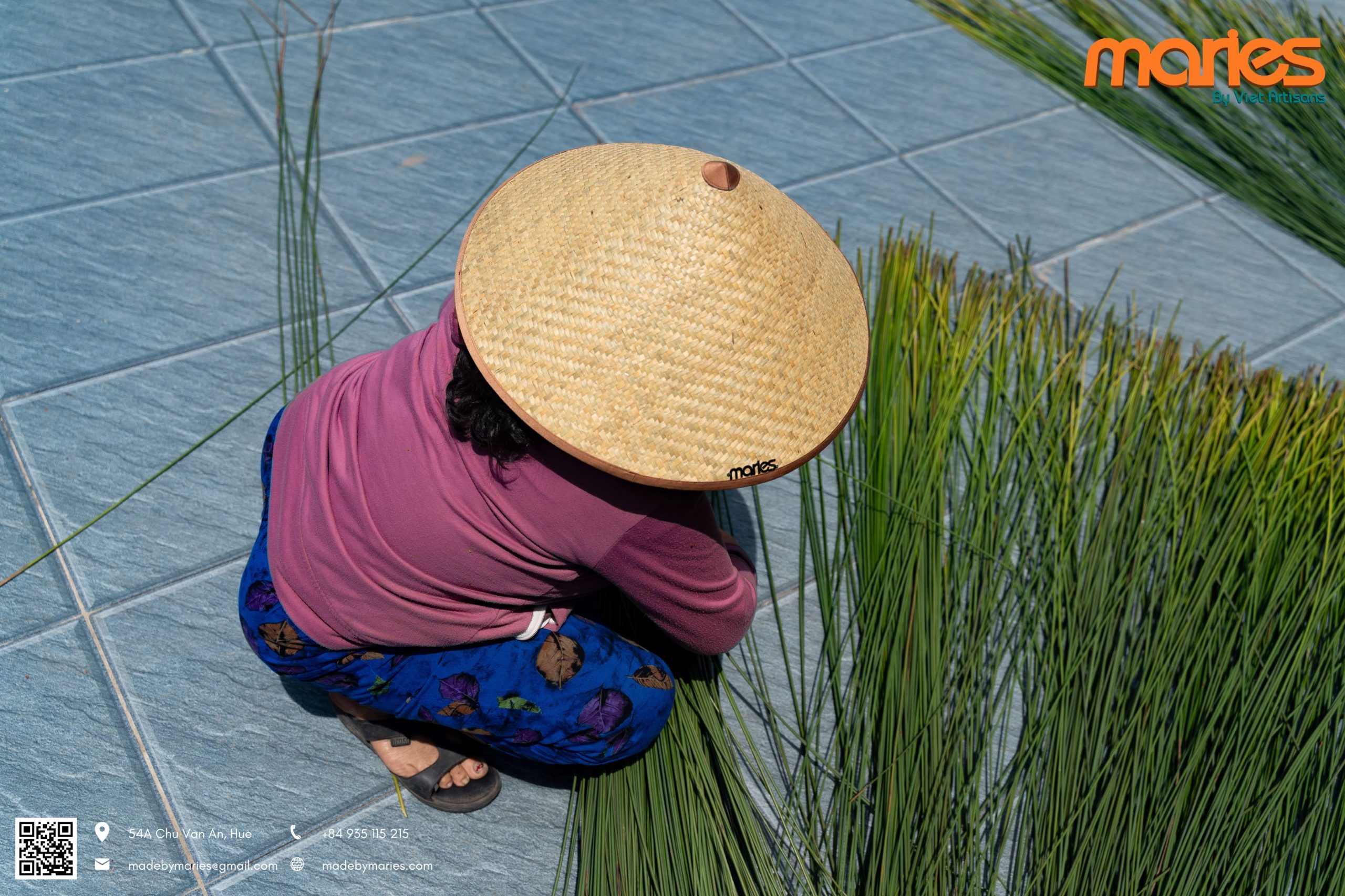
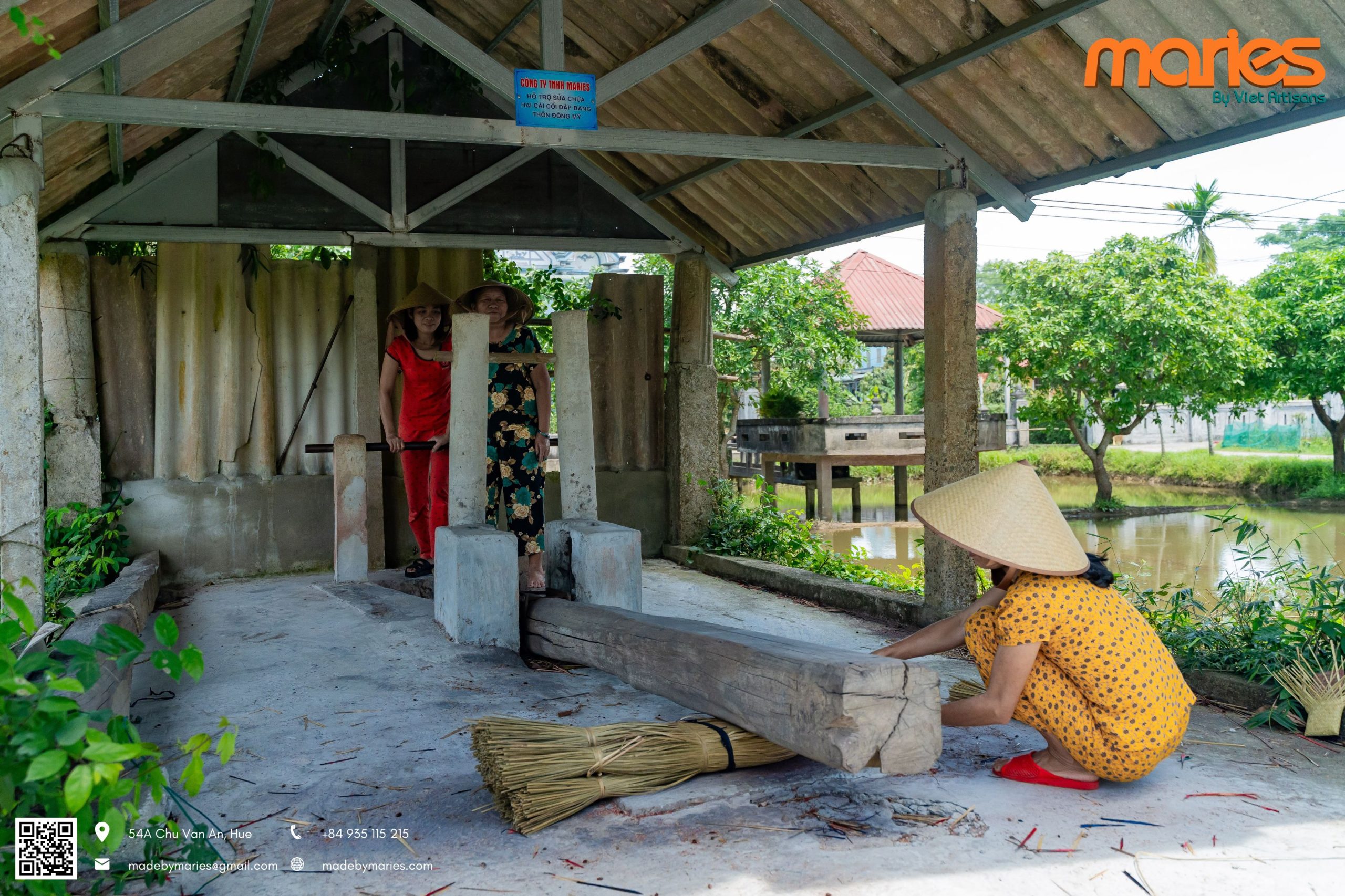
Lepironia Harvest Season 2025 – Faith Returns
There was a time when this craft—weaving with Lepironia grass—seemed destined to vanish. The grass still grew, but people began to leave. Young folks no longer cared for these humble strands. The craft village fell quiet, like a riverbed in the dry season.
Then, the young came home.
Maries—a brand built by young people carrying the soul of village tradition—began rekindling faith.
They didn’t just buy up products; they partnered with the village: offering design workshops, picking color schemes, improving techniques to make the grass more durable and the products more appealing.
Now, every bundle is an opportunity. People rush to harvest, to store, to stock up. Every household is lit up. Orders are lined up. Even city kids call home:
“Will this batch be ready, Auntie? The customer’s waiting!”
And the whole village smiles.
“Now, everyone gets excited when they see Lepironia. It’s not like before when we feared no one would want it,” says Nguyệt, pointing to a freshly dried batch.
“Harvesting doesn’t feel exhausting anymore—because we have faith. Faith that someone is waiting for what we create.”
Bags and hats woven from Lepironia grass are now sought after by young people everywhere.
They love the culture, love their roots, and want to proudly show it off to friends at home and abroad. From Huế, Saigon, and Hanoi to Japan, France, and the US—these humble strands are reborn into modern forms, beautiful yet rich in tradition.

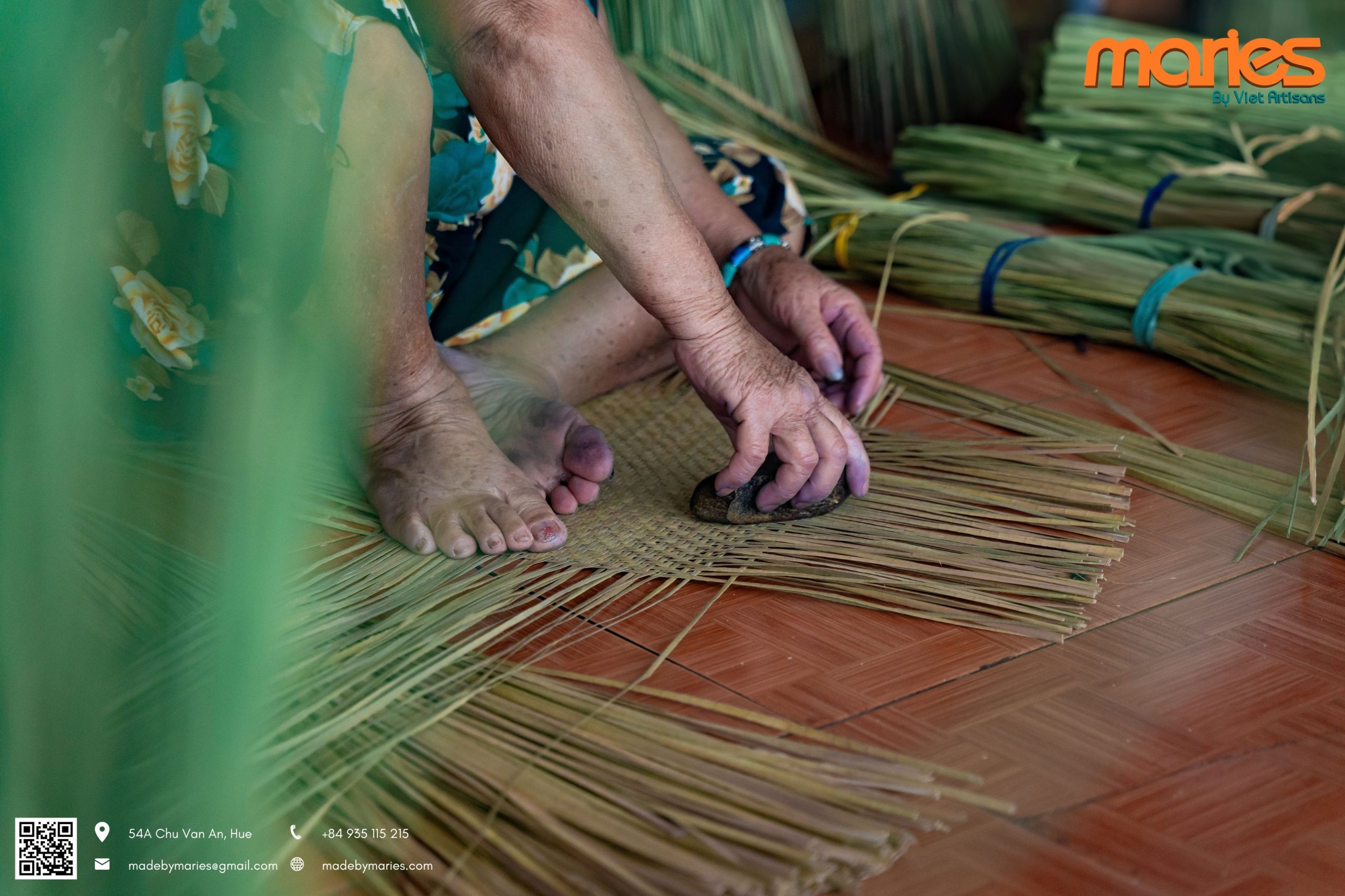
Passing On – Inheriting
Beneath a sun-drenched veranda, as the grass slowly dries, so too do the dreams—carefully warmed, ready to live on in new hands and new journeys.
Preserving a craft isn’t just about hands—it’s about heart.
It’s about the desire to continue.
Aunts and grandmothers in their 60s and 70s are now passing down each weaving technique, each secret, to the younger generation. Women in their 40s have become skilled artisans, now teaching newcomers.
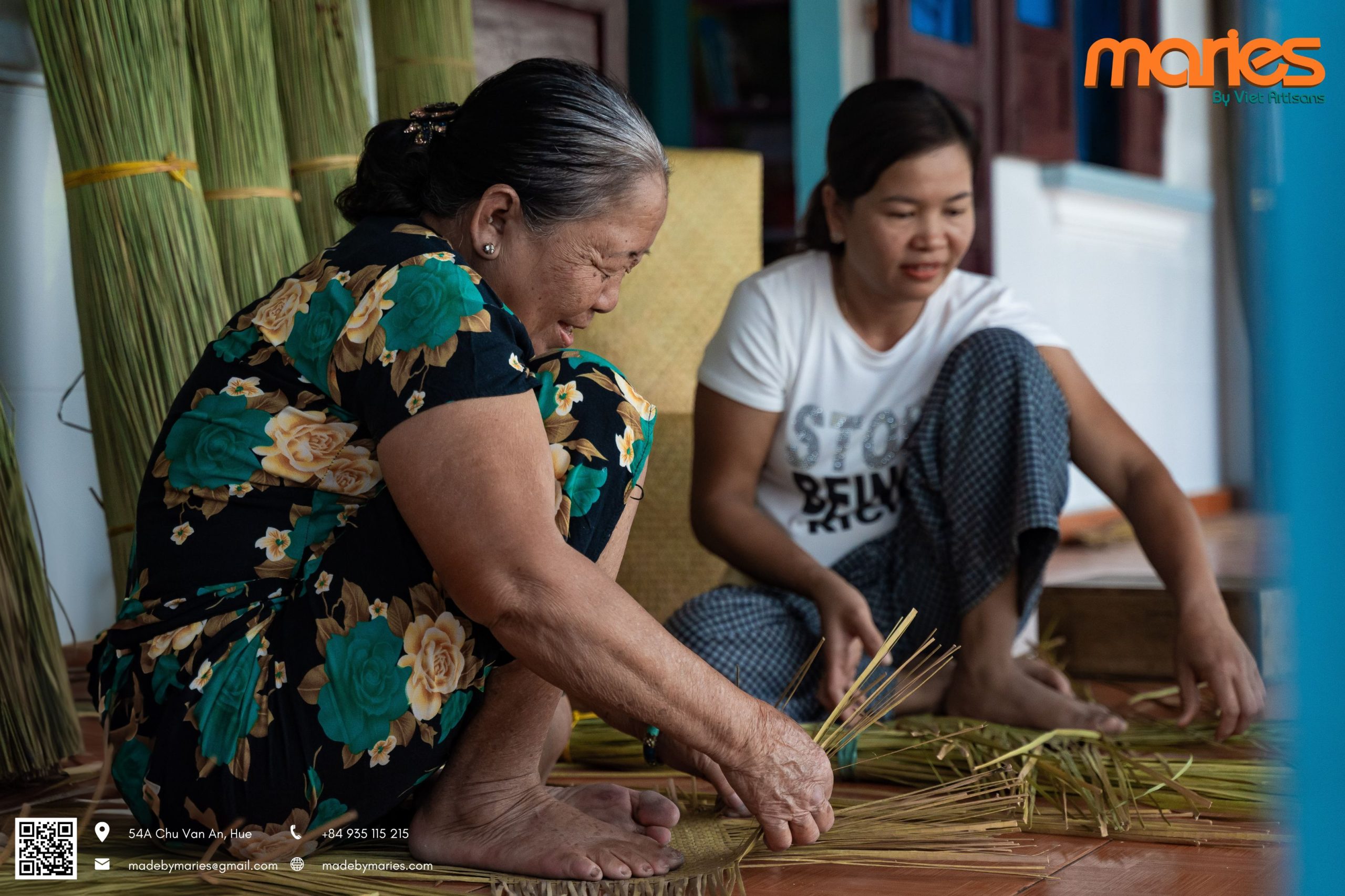

The village is alive with energy. The sound of grass cutting and drying blends with chatter about new designs and patterns. Each person contributes. Every yard becomes a workspace.
Lepironia grass is now the reason people come together.
Maries doesn’t do the work for the village—it gives back the faith that this craft is worth preserving, worth living with.
The Lepironia Grass Harvest Season of 2025 is not just about collecting plants—it’s a season of awakening.
Where young people choose to return.
Where businesses choose to walk alongside the community.
Where artisans choose to keep weaving.
And where each grass strand, from the hands of Phò Trạch, quietly leaves the village—carrying with it the breath of the land and its people—ready to live another life, longer and more radiant.
No textbook holds these folding techniques, these woven patterns.
They can only be learned by seeing, touching, and loving the craft.
A treasure that can’t be sold or rushed—only passed down through many seasons of sun and wind.
And one day, when someone picks up a Lepironia grass bag,
they’re not just holding a handmade item—
They’re holding a season of sun, a village’s story, and the quiet laughter of a weaver in a countryside yard.
“So that each strand of Lepironia grass is not just a wild roadside plant,
but the lifeblood running through a weaver’s hands – beating as the resilient heart of a reborn village craft.”

Let’s walk with Maries through the Lepironia Harvest Season 2025 💚
